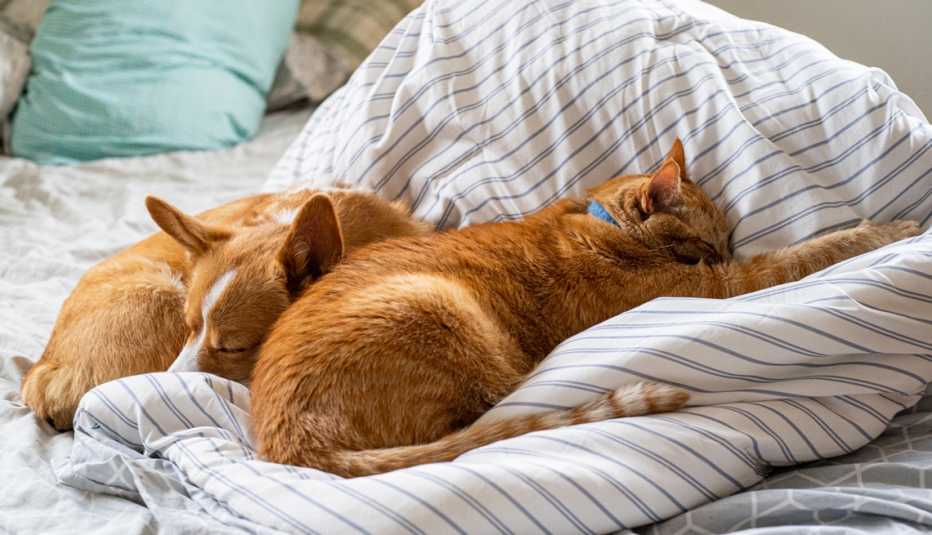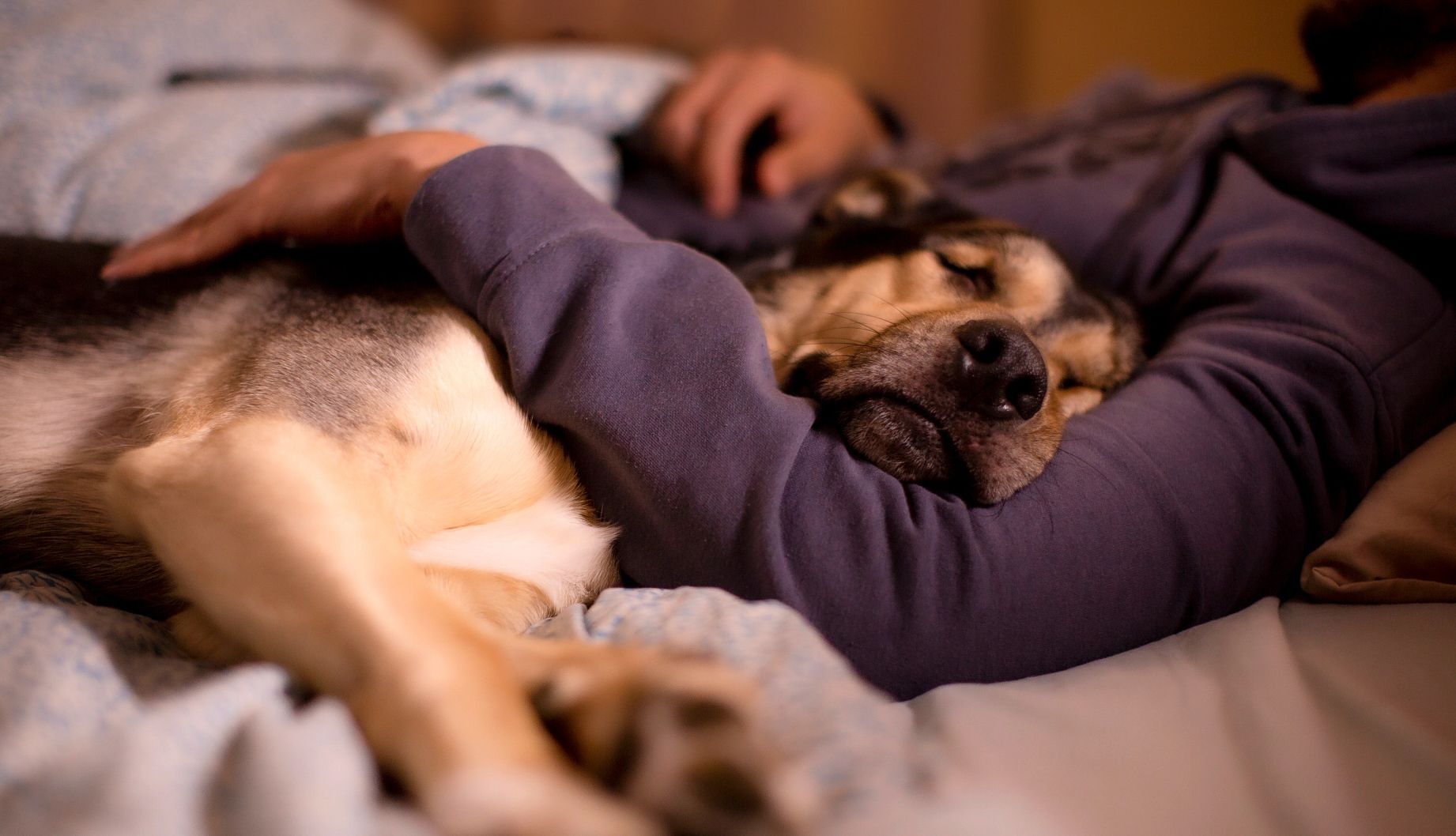Sharing a bed with furry friends may not be a good idea, except when it is

When Pam Lewis, 53, brought home Squeak, a tiny Chihuahua mix she rescued during the pandemic, she planned to have her sleep in her crate, like her previous dogs.
“I’ve always believed that a dog shouldn’t sleep in the bed,” she says. She never intended to make an exception for Squeak.
Then Squeak got a respiratory infection. “She was really miserable, really sick, and there was a night or two where I just wanted to make sure she was OK all night, so I put her in the bed,” says Lewis, who lives in Chicago.
Now Squeak cuddles up to Lewis in bed every night, and that’s a problem. “She wants to be right next to me or on me, and I’m not sleeping well,” Lewis says. “I’ve hit a threshold. We really need to get her back off the bed.”
The case against pets in the bed
This scenario isn’t uncommon, says Kwane Stewart, veterinarian and founder of Project Street Vet. In his more than 25 years of practice, he’s heard this story many times from clients — and he’s been in the same boat himself. He used to allow his dog in his bed, but over the years, good sleep has become harder to come by, and he now maintains a pet-free sleeping space.“There’s the pet’s health, and there’s your health,” Stewart says. “As much as you’re looking out for your pet’s health, you’re also looking out for yours.”
Here are some reasons why you may not want your pet to share your bed.
1. Possible injury
Jumping in and out of bed is more of an athletic feat for our dogs than it is for us, and for long-backed dogs like corgis, small breeds, puppies whose bones are still growing or dogs with arthritis, that type of movement can be downright dangerous.
“About 20 percent of all dogs have some form of arthritis, and jumping on and off a bed is not ideal for maintaining joint health,” Stewart says.
Dogs with a long, low build are more likely than others to suffer a back injury due to that repetitive motion. “Dachshunds are the leader in that territory. They can slip a disc or worse — I’ve seen them come in paralyzed,” he adds. There’s also the potential for injury from falling off a bed while dreaming or if a pet has a seizure.
With cats, the likelihood of injury from falling or jumping is far less in general, Stewart says. “However, older cats do have a high incidence of arthritis, which many people don’t realize,” he explains.
After age 9, many cats may begin experiencing pain in their joints, which can make it harder for them to jump up and down from their favorite places. “If you see your cat sit there and look at their spot, instead of walking over and jumping right up, that’s a sign they might be having issues.” This is a good thing to discuss with your vet, since there are treatments to help reduce the pain.
And it’s not just pets who might get injured. Groggy humans making a midnight visit to the bathroom could be tripped up by pets.
2. The threat of parasites
When you invite your pet onto the bed, you may also invite fleas and ticks, which climb aboard your pets while they’re outside (especially during warmer months), burrow into their fur and feed on their blood — and possibly yours, too, once they’ve hitchhiked into your house. Not only do fleas and ticks cause discomfort and itchiness, but they can infest your home, and their bites can lead to infection. In the case of ticks, their bites can also lead to Lyme disease in pets and humans. Dogs, particularly those who spend lots of time outdoors, are more likely to carry fleas and ticks than cats, Stewart says. “Cats are so fastidious that, even if they get a flea or two, they’re always grooming themselves. They’ll catch a random flea before it can find a home and breed,” he says. Still, he recommends flea and tick preventive treatments for cats and dogs, especially if they spend any time outdoors or are in contact with other pets who spend time outdoors.
Pets can also transmit ringworm to their humans, and Stewart has identified ringworm spots on pet owners in his clinic, more often when the pet sleeps in the bed, since that’s a prime place for close-up cuddling.
Since ringworm is transmitted by skin-to-skin contact, it’s worth keeping an eye on your pet for any circular areas of hair loss on their bodies.
3. Poor sleep quality
If you have a dog or cat who sleeps soundly, it may not bother you to have pets in your bed. After all, around half of pet owners allow a pet (including cats, dogs and other animals) to sleep on their bed, according to Australian researchers. It’s hard to imagine this would be so commonplace if it disrupted sleep significantly. Still, a 2017 study from the Mayo Clinic on the effect of dogs on human sleep in the home found that, in general, sleeping with a dog in the bedroom did not hinder sleep, but having the dog on the bed did.
It’s worth noting, though, that Michael J. Breus, clinical sleep specialist and founder of The Sleep Doctor, finds most people tend to fall back asleep quickly, even if their pet wakes them with movement or snoring. Unless the sleeper complains, he doesn’t think of those disruptions as problems.
Although cats are usually smaller than their canine counterparts, some pet parents find them more disruptive to sleep, Stewart says. (Cats do, after all, tend to engage in more nocturnal activities than dogs.) In fact, in Stewart’s home, his family has had to keep their cat, Rosie, out of all their rooms thanks to her propensity for late-night kneading sessions and curling up directly over their faces.
4. Increase in asthma or allergies
Dog and cat allergies are common, affecting 10 to 20 percent of the global population. If you’re part of that group, contact with your pet might cause you to experience symptoms like coughing and sneezing, runny or stuffy nose, itchy eyes or even trouble breathing, especially if you have asthma. Since pet dander and saliva cling to fabric like bedding, having your dog or cat snuggling into your sheets can exacerbate your symptoms — even if your pet is not actually in your bed at the same time you are.
For people who have serious pet allergies, making the bed a no-go zone may be a wise move, but be aware that dander can remain in a home or room for a few months, even if the pet hasn’t set a paw inside.
5. It’s a romance blocker
Some couples bond over their love of cats and dogs, but that doesn’t mean having pets in the bedroom is ideal for their love life. “As for romantic relationships and intimacy, this can be an issue. Many animals do not understand what’s going on and may think some type of harm is being done and can get defensive,” Breus says.
What, precisely, sets them off is likely to vary from case to case, Stewart adds. Cats are unlikely to pay much mind to what you’re doing, he says, but “for some dogs, the motions and noises [of sexual intimacy] can be startling, confusing, and in some cases they may get aggressive.”
A number of other factors may be at play as well. “Is this a new relationship? There could be a higher potential for issues if, for instance, the girlfriend had the dog for years, and now the boyfriend is moving in, entering the dog’s domain, taking over the bed when the dog is used to being there,” Stewart says.
If you have any concerns about your pets reacting to your romantic activities, redirect their attention: “Give them a toy and have them find another place to hang out for a while,” Stewart says.
There’s no denying the fact that your dog walks — and possibly rolls around — in dirt outdoors, and your kitty pads through the litter box several times a day. Any dirt or germs on their feet and fur won’t magically disappear when it’s time to climb into bed, but they may rub right off on your comforter.
And there are other concerns, like the fact that urinary incontinence, especially in female dogs (but not cats), is common as they age, says Stewart. Medications can help with this issue, but it’s worth considering whether a pet in the bed is worth the risk of them wetting the bed.
